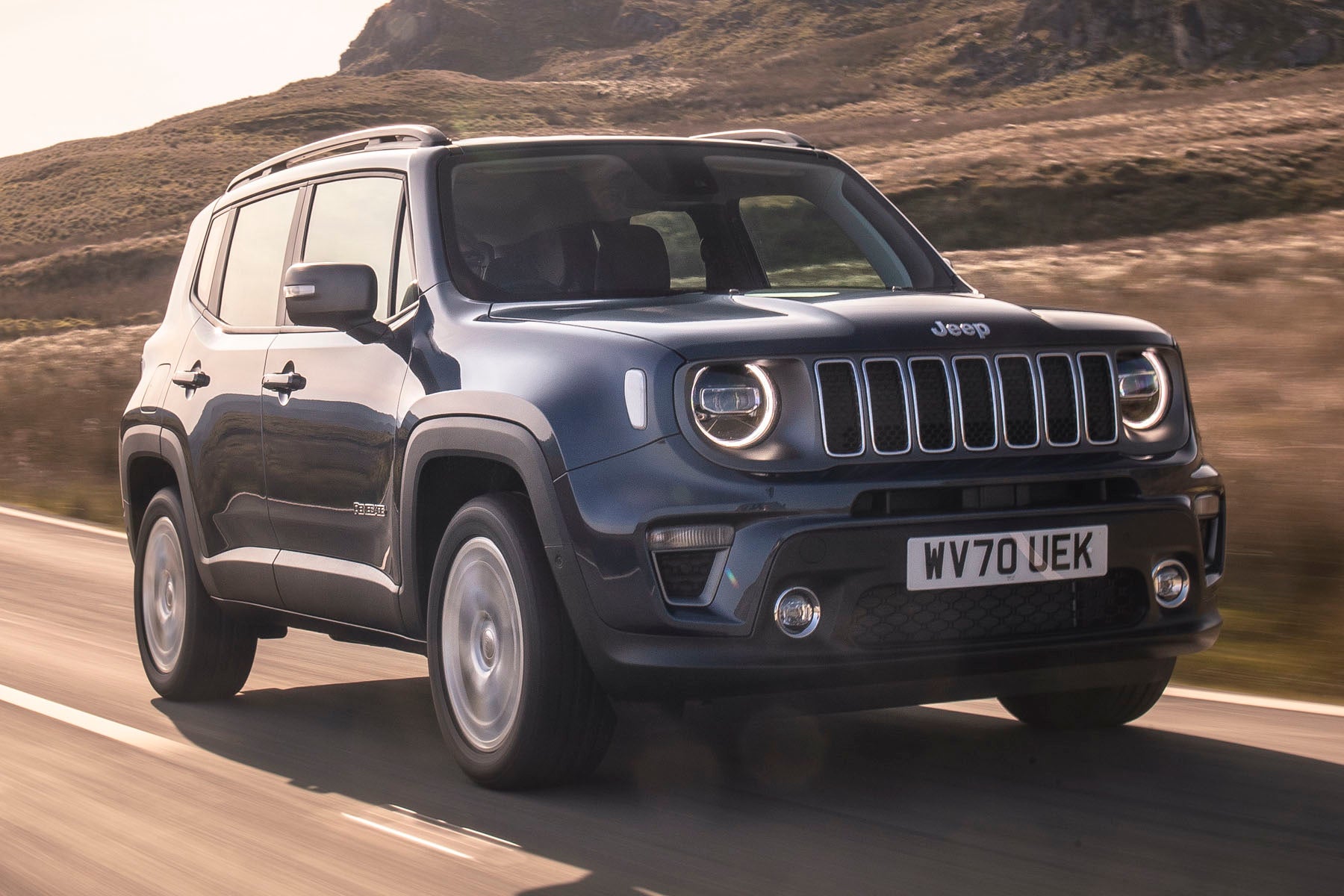Jeep Renegade Review 2025: Price, specs & boot space
Written by Andrew Brady
Quick overview
Pros
- Brings a sense of fun to an otherwise rather staid market
- Four-wheel-drive models are capable off-road
- More spacious than some alternatives
Cons
- Interior looks (and feels) pretty cheap and nasty
- It’s not very sophisticated on the road
- You’d have to really want a Jeep
Verdict: Is the Jeep Renegade a good car?
"In this 2025 Jeep Renegade review, we're taking a close look at yet another contender in the crowded small SUV sector. The unmistakably chunky looks and vertical grille of a Jeep holds special appeal for some, but behind the mask is a small SUV with a modest set of abilities. It delivers a less-than-stellar driving experience, the interior feels off the pace compared with rivals, and it's arguably not as good as the Fiat 500X with which it shares a lot of hardware. It is usefully roomy and decent value for money, though, and your kids will probably think it's ace."

You’d struggle to tell that the Jeep Renegade shares its platform and engines with the decidedly unrugged Fiat 500X. For its smallest model, Jeep has pulled out all of the stops, with quirky looks, a rugged interior and genuine off-road ability (if you buy a four-wheel-drive version).
It’s easy to see the appeal when rivals range from the competent (if a bit bland) Renault Captur to the rather bland VW T-Cross. The Jeep badge alone will be enough to attract the attention of a lot of crossover buyers, with its military off-roader connotations and slightly brash image.
The good news is that the Jeep Renegade is a fairly affordable way into Jeep ownership. It's been around for a ludicrously long time now - more than a decade - and so an early model could cost you less than £5,000 (depending on specification), while even as-new examples start from around £15,000. That’s tempting value, and it shouldn’t cost a lot to run, either.
There have been numerous petrol and diesel engines available throughout the car's long life, with some of the most frugal capable of late-40s mpg. The diesels are a little unrefined, though, (it’s almost like Jeep’s done away with some of the sound insulation to make the Jeep Renegade feel like a proper off-roader), so we’d stick with a petrol - particularly if you don’t cover many miles.
The Jeep Renegade range was updated in 2018 with the addition of new 1.0- and 1.3-litre petrol engines (as per the Fiat 500X), while in 2020 a plug-in hybrid version was also added called the Renegade 4XE, alongside a mild-hybrid 1.5-litre petrol. These last two hybridised powertrains are the only two options still offered in brand new Renegades.
If you're buying used, the 1.3-litre is let down by its standard automatic gearbox, so we’d go for the little 1.0-litre three-cylinder unit. It might sound small for a car like this, but it’s quicker than you’d expect and also the most refined choice.
The Jeep Renegade 4XE PHEV uses the same 1.3-litre engine but adds a 60PS electric motor driving the rear axle to give it four-wheel-drive, and a total of 190PS, or 240PS in Trailhawk spec. That gives it a useful performance boost, and it can cover a claimed 22 miles on electric power alone.
The mild-hybrid version is also worth a look if you drive a lot in town. It’s unusual among mild hybrids in that it can drive for short distances on electric power alone, which could reduce your fuel bills considerably. It’s also a good chunk cheaper than the PHEV.
With light steering and compact dimensions, the Jeep Renegade is an easy car to drive around town. The numb steering and notchy gear change mean it’s a bit frustrating to drive out of town, though, while a fairly vast amount of body lean through corners adds to the old-school feel.
If you fancy a bit of mud-plugging, the off-road-biased Trailhawk model is worth seeking out on the used market. This adds the kind of things that’ll appeal to 10-year olds: extra underbody protection, bespoke off-road wheels and hill descent control to help tackle steep slopes. It also comes with four-wheel-drive, of course, which provides plenty of reassurance in poor conditions but increases fuel consumption the rest of the time.
The Jeep Renegade feels fairly spacious inside, although it’s a long way from being a premium alternative to cars like MINI's Countryman. You could be forgiven for thinking it’s a much older cabin than it actually is, with lots of harsh plastics and chunky (but low-rent) buttons. An updated 8.4-inch infotainment system arrived in 2018, though, bringing with it Apple CarPlay and Android Auto. The system was overhauled again for 2024, with a 10.1-inch screen and wireless Apple CarPlay and Android Auto.
Should you buy the Jeep Renegade? As a new car it’s very hard to recommend, as it’s now more than a decade old, but there's plenty going for it as a used car. For instance, it’ll stand out on your driveway more than Renault Captur or Nissan Juke, and it’s available in some bold colours. It’s also the best-value Jeep on the market, and it shouldn’t cost a fortune to run.
Looking for a used car for sale? We've got 100s of Jeep Approved Used Cars for Sale for you to choose from, including a wide range of Jeep Renegade models for sale.
Is the Jeep Renegade right for you?
There's no shortage of small SUVs and crossovers to choose from, whether you're looking for maximum space in a minimal footprint, or something that's fun to drive. The Jeep Renegade doesn't really excel in any particular area, other than being the most American-inspired vehicle in the class. However, there are few plug-in hybrids in this sector, so it's worth at least taking a look at the 4XE version if you want some EV capability.
What's the best Jeep Renegade model/engine to choose?
Unless you need a diesel or four-wheel drive, we’d recommend the little 1.0-litre petrol engine that arrived in 2018. It packs plenty of punch and comes with a slick manual transmission, which is less frustrating than the dual-clutch automatic that’s paired with the 1.3. The Jeep Renegade 4XE is by far the quickest version and offers potentially low running costs, but even the cheapest version is very expensive. If you do lots of in-town driving, the mild-hybrid Renegade e-Hybrid is worth checking out, as its capability for electric-only driving can make a good dent in your fuel bills.
The Limited and Upland specifications offer the best balance of kit and affordability. For later models, stick to the Altitude and Summit trims unless you need to do lots of off-road driving.
What other cars are similar to the Jeep Renegade?
The Jeep Renegade is closely related to the Fiat 500X which, although it lacks the rugged image of the Jeep, we reckon is actually a better choice. The Suzuki Vitara is another good alternative, while the Nissan Juke and Renault Captur are both popular choices in this class. We’d recommend the practical Honda HR-V, too, while the SEAT Arona is good to drive.
Comfort and design: Jeep Renegade interior
"The Jeep Renegade has the kind of rugged interior you'd expect of a proper SUV. That said, one person's 'rugged' is another person's 'cheap and nasty'."
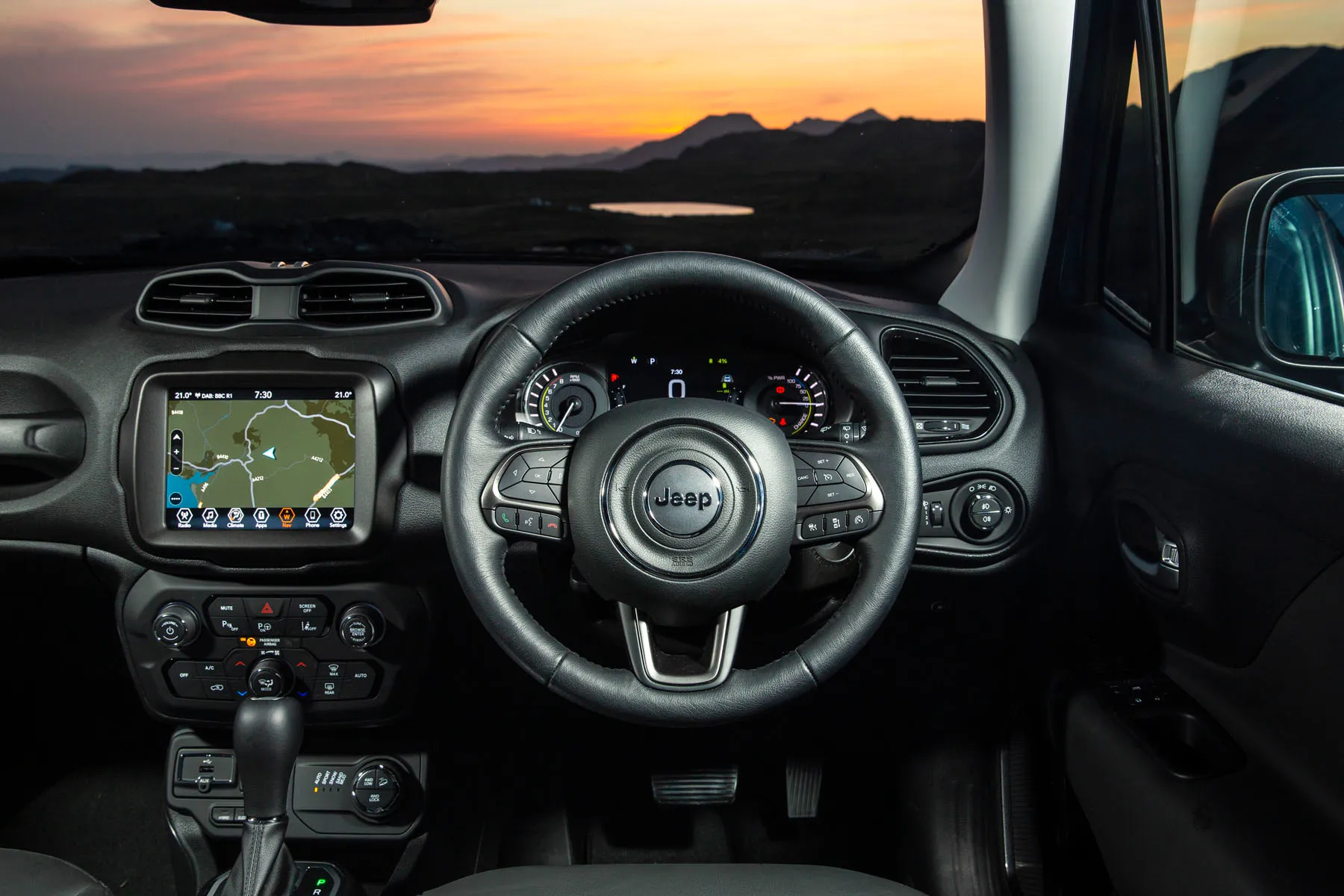
The layout is fairly conventional and intuitive, with all the main controls easy to operate. The instrument dials are simple and, on Limited models and up, include a large colour display between them, giving you all the trip information in an easy-to-read and nicely designed fashion. Lower trim levels have to make do with a smaller monochrome display, unless you’re looking at a 2024-onwards model, in which case all versions get the 10.25-inch digital instrument cluster as standard.
Quality and finish
From a distance, the interior of the Jeep Renegade looks appealing, with a pleasingly chunky design theme that matches the rugged exterior. Get a bit closer, however, and the reality is that most of the materials used are below average in quality, with lots of hard, scratchy plastics and flimsy switches.
Infotainment: Touchscreen, USB, nav and stereo in the Jeep Renegade
Early versions of the Jeep Renegade got infotainment screens measuring 5.0 inches or 6.5 inches in diameter depending on the trim level, while post 2018 cars all got an 8.4-inch touchscreen as standard. From 2024, the screens were enlarged to 10.1 inches. All had DAB radio and Bluetooth, most had nav (only early entry-level Sport cars missed out), while later systems have Apple CarPlay and Android Auto, which is wireless in post-2024 cars.
All the systems work pretty well, too, despite being smaller than many touchscreen offerings. The shortcut buttons make it easier to skip straight to another function without having to sift through several menu screens, while the phone mirroring on the later system means you can skip the built-in nav if you'd rather use Google Maps or Waze (and we’d recommend you do: it’s not great to use).
Space and practicality: Jeep Renegade boot space
The Jeep Renegade has dimensions of 4236mm in length, and 1805mm in width, while the height of 1667mm makes it a little taller than many rivals, as you might expect from something with off-road aspirations.
Space for those is the front is excellent, with generous head- and legroom. In the back, it's a similar story in terms of headroom, but legroom is a little less plentiful, and the rear bench is best suited to two people rather than three.
The Jeep Renegade's boot offers 351 litres of space with the rear seats in place, but this goes up to 1,297 litres with the rear seats folded. If you go for the PHEV 4xe model, that space drops to 330 litres because of where the batteries are located.
What engines and gearboxes are available in the Jeep Renegade?
"Poor gearbox and engine combinations have traditionally let down the Jeep Renegade, although most models have reasonable running costs. The Jeep is also one of the few cars of its ilk that you can realistically take off road and it's also a good choice if you need a small SUV for towing."
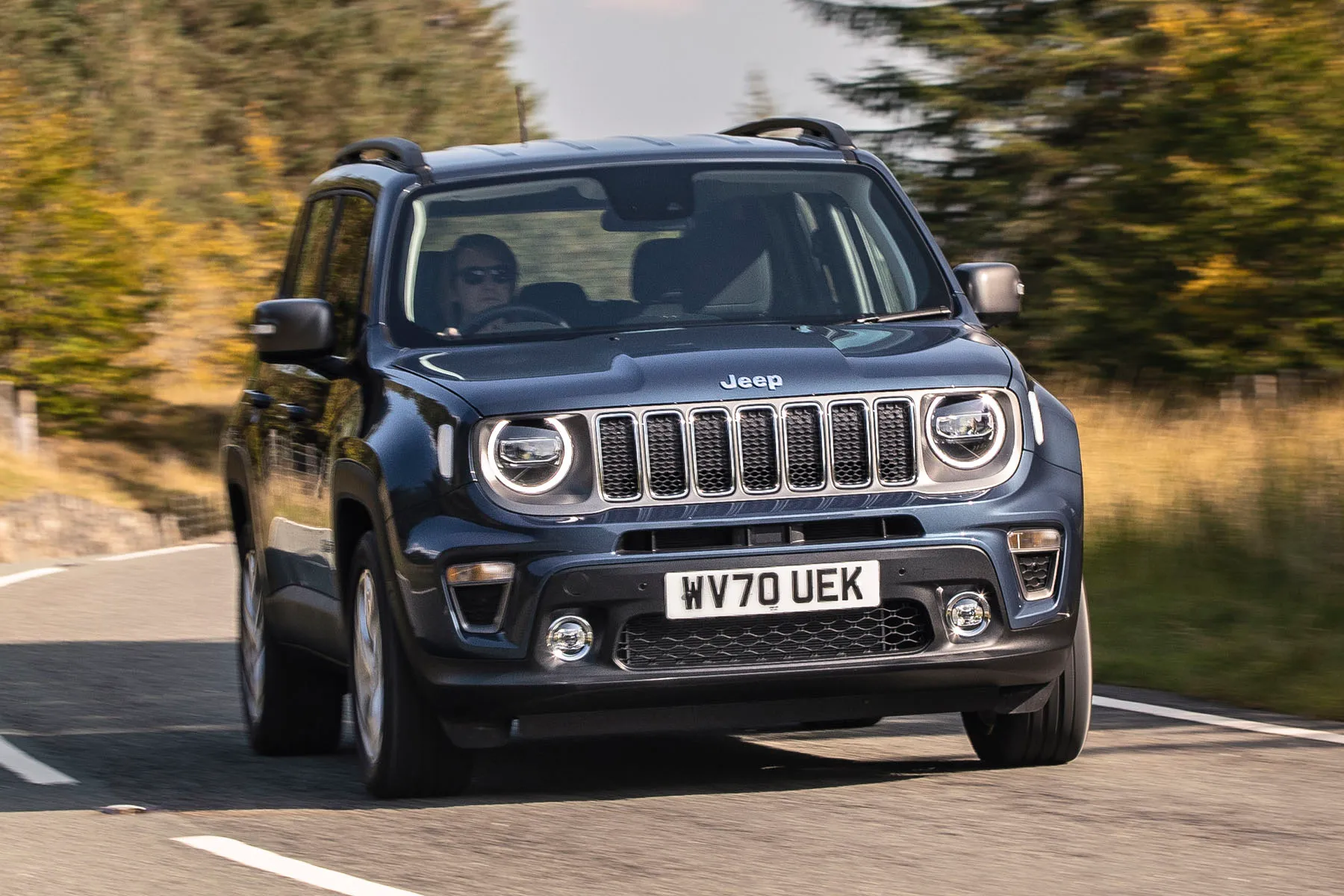
The Jeep Renegade has been available with a variety of different engines over the years. At launch, there was a 1.6 petrol with 110PS or 1.4 MultiAir turbos with 140PS or 170PS. The 1.6 is best avoided unless you mainly travel around town on your own, because if you need to go faster, or carry people or stuff, it starts to feel rather underpowered. The 1.4s are fine, though. Diesel choices included a 1.6 with 120PS or 2.0-litre units with 140PS or 170PS, but we never got to try these.
Things changed with a facelift in 2018. The petrol range then began with a 120PS three-cylinder 1.0-litre petrol. It's a thrummy little motor that works fine in town but can feel a little lacklustre when speeds rise. Sure, it'll handle motorway slogs with no issues, but if you're planning on overtaking streams of traffic on A roads then, well, you might want to rethink that strategy.
Then came the more powerful 150PS, four-cylinder 1.3-litre petrol, which wasn't much better, because it was hamstrung by its standard six-speed automatic gearbox. Perplexingly, 0-62mph takes 11.8 seconds, exactly the same as the 120PS model with its six-speed manual.
Next up are the 170PS four-cylinder 2.0-litre diesel and the 180PS version of the four-cylinder 1.3-litre petrol. Both get a smooth-shifting, nine-speed automatic gearbox and four-wheel drive – so they're good for off-roading and towing – but they were expensive when new and so are harder to find on the used market, although if you can, they're good value due to the Renegade's steep depreciation.
Things have since changed again. The entry-level motor is now the 1.5-litre mild-hybrid Jeep Renegade E-Torque petrol, which offers a modest 130PS. It makes a decent fist of getting the Renegade where you want to go, but it needs to be driven with care to get anywhere close to the official combined fuel consumption of 48.7mpg.
From 2022, this system was upgraded to allow small amounts of electric-only driving: this version is badged e-Hybrid and should deliver more like 51mp. It’s decent to drive, too, with extra oomph from the electric motor that’s incorporated into the seven-speed automatic gearbox.
Probably the best of the bunch is the plug-in hybrid option, the 4XE, which takes the 1.3-litre petrol engine and adds a 60PS electric motor, giving either 190PS or 240PS depending on the trim level. That gives it useful performance: in the top spec Trailhawk, the 0-62mph sprint is dispatched in a sprightly 6.9 seconds. Fuel consumption is given at as much as 135mpg, and the car can travel up to 22 miles in EV mode.
Handling and ride quality: What is the Jeep Renegade like to drive?
No one should be looking at a car like the Jeep Renegade expecting a scintillating drive, so it shouldn't be too much of a disappointment that it isn't. The steering is sufficiently responsive and there's a decent amount of grip available, but push harder, and there is inevitably quite a lot of body roll. However, the Jeep Renegade is stable, secure and won't get you into trouble.
Less impressive is the ride quality, because the suspension begins to struggle noticeably once the road surface starts to deteriorate. It jitters over rippled and rutted surfaces, and can really thump over potholes. In a car designed to have at least some off-roading ability, you'd expect a more absorbent ride.
Refinement and noise levels
The Jeep Renegade is a relatively small car and that's never more noticeable than at higher speeds, where the mix of engine-, wind- and road noise is fairly prevalent. It's acceptable, but refinement is not the car's strongest suit and there are better alternatives that offer more serenity on long journeys.
Around town there's less to grumble about, and in particular, the 4XE and e-hybrid versions offer the bonus of near-silent running when in EV mode.
Safety equipment: How safe is the Jeep Renegade?
Euro NCAP tested the Jeep Renegade in 2019 and it received a below-average three stars out of five. Its scores of 82% and 84%, respectively, for adult and child occupancy protection were good, but the pedestrian impact rating of 55% and 58% for safety systems were relatively poor, dragging down the overall score.
Newer Jeep Renegade models have a better suite of safety systems as standard, with features like adaptive cruise control and lane departure warning now included, but if you're buying used, you may have to shop around a little more to find an example with a better selection of kit.
MPG and fuel costs: What does a Jeep Renegade cost to run?
"As you’d expect, the plug-in hybrid Jeep Renegades are potentially the most efficient, but it very much depends on how many short journeys you do and how often you can charge the battery."
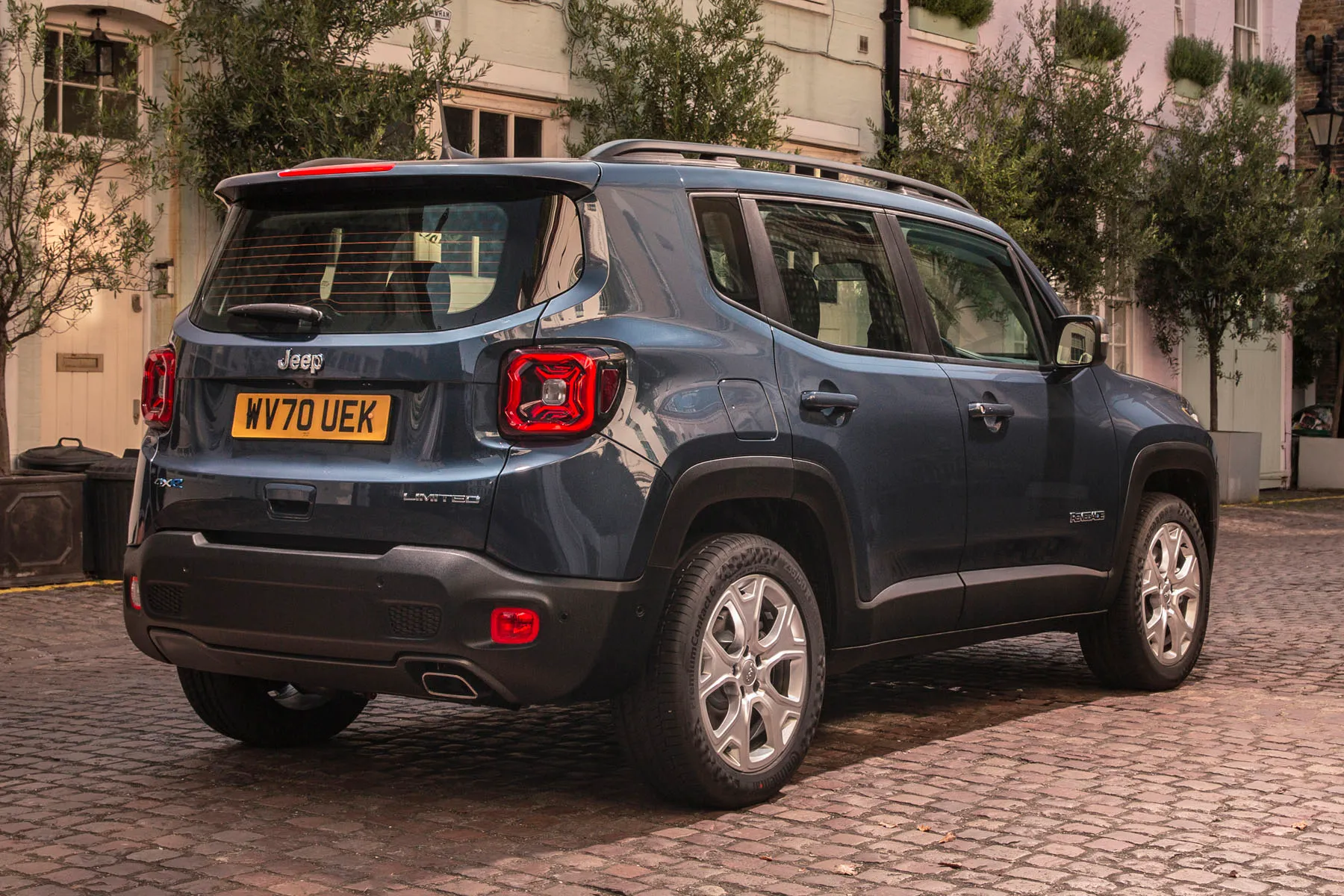
The 120PS 1.6-litre diesel officially returns up to 48.7mpg with the manual gearbox, dropping to 47.1mpg as an automatic. The 140PS 2.0-litre 4x4 provides up to 40.9mpg, falling to 37.7mpg with the automatic transmission. The off-road Trailhawk model with a 170PS version of this engine returns 35.8mpg.
There’s not much difference in fuel economy between the 1.0- and 1.3-litre petrol models. The 1.0-litre officially returns 37.2mpg while the 1.3 achieves up to 39.8mpg in WLTP tests. Whichever way you slice it, none of these figures are particularly dazzling. Things are better with the Renegade e-Hybrid, which promises up to 49.5mpg: it’ll be better if most of your driving is stop-start around town, and it’s not a huge jump up in price, either.
The official WLTP fuel consumption of the Jeep Renegade 4XE plug-in hybrid versions is given at p to 135mpg, but as you'll probably know, this is not especially representative of the real world because the official tests are unrealistically flattering to plug-in hybrids. If you can charge at home and spend a lot of time running around town on short journeys then you can use EV mode for a large proportion of the time, but on longer journeys you'll find a diesel engine will almost always be a better bet.
Jeep Renegade reliability and warranty
In the latest 2025 edition of the HonestJohn.co.uk Satisfaction Index, Jeep did poorly in the manufacturer standings for reliability. That's putting it mildly: it came 32nd out of 33 carmakers, ahead of only Alfa Romeo, which is part of the same company. It's not clear how much of a hand the Renegade had in that performance, but it's worrying nonetheless. Jeep's warranty isn't much good, either with only two years of manufacturer cover and a third year of retailer-supplied cover.
Jeep Renegade insurance group and costs
Remarkably, the Jeep Renegade manages to squeeze into group 8 for the lowest version in its earliest guise, but even the majority of versions over the years fall between group 9 and group 14.
2.0-litre diesel versions are a bit higher in group 15, while the 4XE hybrids are higher still in group 22 for 190 PS version and 25 and 26 for the 240PS versions.
VED car tax: What is the annual road tax on a Jeep Renegade?
Before April 1st 2017, cars were taxed according to the level of CO2 they emitted. As such, some of the more modest diesel Renegades registered before that date qualify for tax as low as £35 per year, but most others will be around £180 to £200 per year. On all cars registered after that date, you'll pay the same flat rate of £195. However, the priciest versions sit perilously close to the £40,000 threshold for luxury cars, and can/could easily be pushed over by adding a few optional extras. It's worth doing an online check using the registration of any used example you're considering, because if you bust the threshold, you'll have to pay an additional surcharge of £425 per year between years two and six of the car's life.
Jeep Renegade price
"The earliest examples of the Jeep Renegade are now in pretty cheap territory. Less than £7,000 is required to put you in an early 2015 or 2016 car with around 70,000 miles on the clock, and it's entirely possible that these examples will have either one of the punchier engines, or posher trim levels, or both."
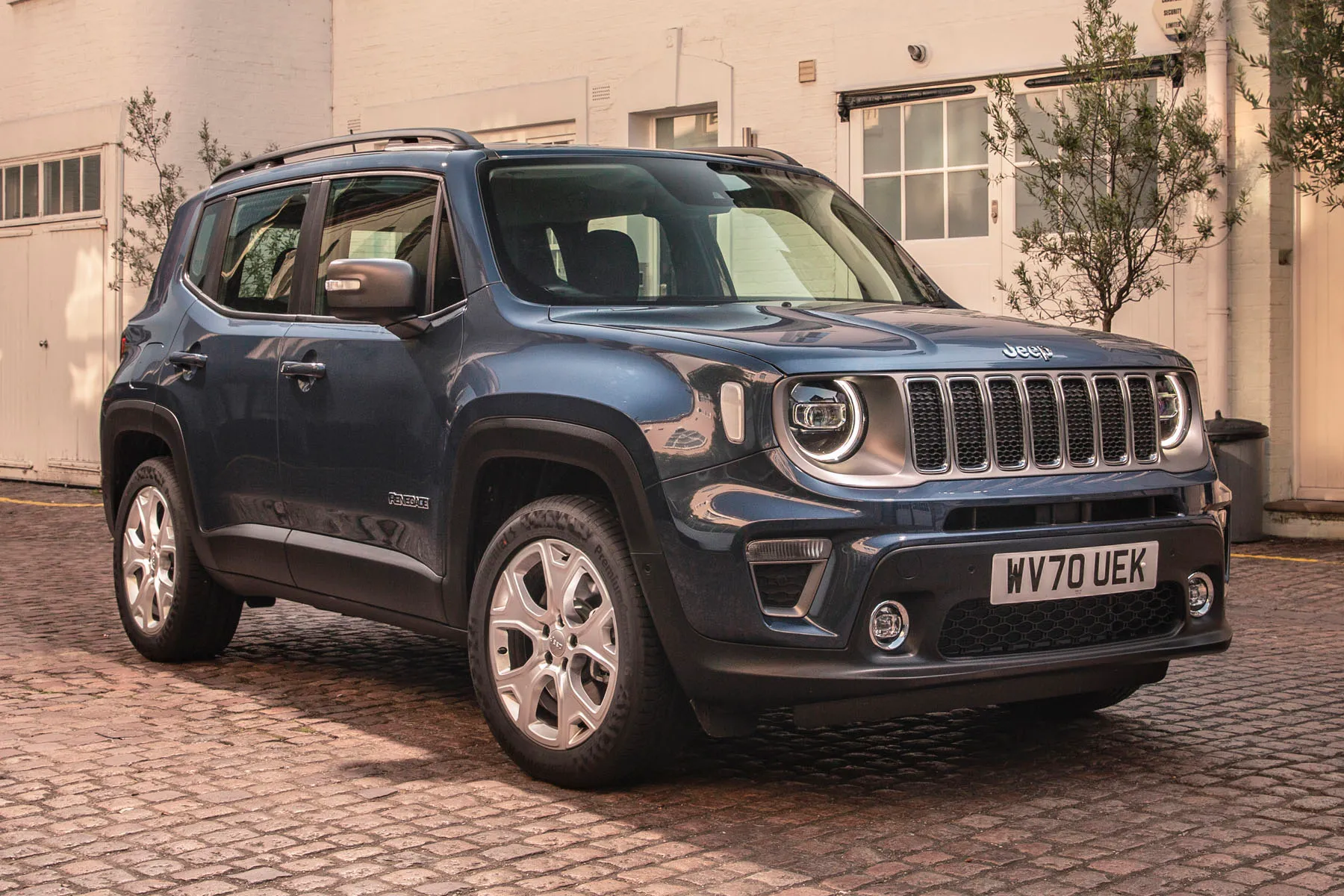
Plug-in hybrid variants are thinner on the ground given that they were introduced a lot more recently, but if you can find an early one from 2021 or thereabouts, it can be yours for around £18,000.
Trim levels and standard equipment
Jeep has tinkered with the Renegade's trim structure almost constantly throughout its stupendously long life, and there are seemingly dozens of different trim levels available on the used car market (we counted 19 the last time we totted it up, although we could've missed one or two as we were worried about running out of fingers). The level of kit you get with each has varied quite a bit over the years, too. If you can, find one of the fabulously named special edition models, which are better value: besides, who wouldn't want to drive a car called the 'Desert Hawk', the 'Night Eagle II', the 'Tough Mudder' or - our personal favourite - the 'Dawn of Justice'?
In 2022, the trim levels were pared right back to just the Limited and the Trailhawk. Limited cars got 17-inch alloy wheels, fabric seats, dual-zone air-con, the 8.4-inch infotainment screen and a 7.0-inch TFT digital instrument panel, powered windows, adaptive cruise control and rear parking sensors. Trailhawk cars get more rugged styling bits inside and out, power folding door mirrors and front parking sensors.
In 2024 the range was overhauled again, with the lineup starting with Altitude and moving up through Summit, Overland and Trailhawk. Entry-level Altitude cars had LED lights front and back, 17-inch alloy wheels and roof rails, as well as automatic air conditioning and a rear-view camera. Summit added 18-inch wheels and heated seats and steering wheel for chilly mornings, as well as a windscreen wiper de-icer. Overland came with mud and snow tyres – useful if you make regular trips off-road – as well as more rugged bumpers and rear seats that fold in a 40/20/40 split for extra flexibility. Trailhawk remained the most rugged model, with a tow hook and spare tyre enhancing its capability.
These days, the trims available are the North Star and the Summit. The former has LED lighting, roof rails, 17-inch alloys, a sunroof, rear parking sensors and automatic high-beam headlights. The Summit adds heated front seats, front parking sensors and adaptive cruise control.
Ask the heycar experts: common questions
Is a Jeep Renegade a good car?
What problems do Jeep Renegades have?
Does the Jeep Renegade have a Fiat engine?
Get our latest advice, news and offers
Keep me updated by email with the latest advice, news and offers from heycar.
By submitting you agree to our privacy policy
